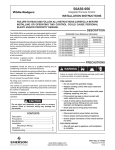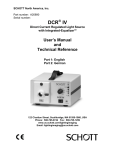Download Whirlpool RJE-3100 Specifications
Transcript
DRYER STUDY COURSE for Home Appliances UNDERSTANDING DRYER: • HEATER ELEMENT/GAS BURNER COMPONENTS and CHECKING PROCEDURES Module 2 LIT 787849 Rev. C For More Appliance Troubleshooting, Repair Help, & DIY Videos Visit A pplianceAssistant.com Note: This Page was not included by Whirlpool Corporation ApplianceAssistant.com is not affiliated Whirlpool Corporation Whirlpool Corporation in no way endorses ApplianceAssistant.com WHIRLPOOL CORPORATION does not assume any responsibility or any liability in connection with the use of this manual. © 1989, 1993, 1996, 2001 WHIRLPOOL CORPORATION All rights reserved. No portion of this book may be reproduced in any form without written permission from WHIRLPOOL CORPORATION. ® The trademarks WHIRLPOOL , , trademarks of Whirlpool Corporation. , and FSP are registered INTRODUCTION The material presented in this module is intended to provide you with an understanding of the fundamentals of gas and electric dryer servicing. Major appliances have become more sophisticated, taking them out of the screwdriver and pliers category. Their electrical circuits include several different types of automatic controls, switches, heaters, valves, etc.. Semiconductors, solid-state controls, and other components usually associated with radio and television electronic circuits are being engineered into automatic washers, dryers, dishwashers and refrigerators. The appliance technician is emerging into a professional status of his own. He must prepare himself now to be able to perform his duties today as well as to retain his professionalism in the future. No longer is on-the-job training sufficient to prepare technicians for the complicated procedures required for todays sophisticated appliances. This training can best be obtained through organized classroom study and application. However, much of the knowledge necessary to service todays appliances can be obtained through study courses. Completion of this and other courses will provide you with sufficient understanding of appliances and their operation to enable you to do minor service. It will also serve as a valuable stepping stone to more advanced study and on-the-job training to improve your servicing skills. Information contained in this module is used on WHIRLPOOL® appliances. 1 TABLE of CONTENTS PAGE CHAPTER 1 - ELECTRICAL COMPONENTS................................................................... 3 Thermostats ....................................................................................................................... 4 Adjustable ....................................................................................................................... 4 Fixed ................................................................................................................................. 5 Operating Thermostats ................................................................................................... 6 High-Limit (Safety) Thermostats .................................................................................. 7 Thermal Fuse..................................................................................................................... 8 Buzzer ................................................................................................................................. 9 Push-To-Start Switch (Relay) ....................................................................................... 10 Door Switch ...................................................................................................................... 12 Two-Terminal ................................................................................................................ 12 Three-Terminal ............................................................................................................. 12 Five-Terminal ................................................................................................................ 13 Temperature Switch ....................................................................................................... 14 Drive Motors ..................................................................................................................... 16 Centrifugal Switch .......................................................................................................... 19 Timers ............................................................................................................................... 20 One and Two Cycle ..................................................................................................... 20 Three and Four Cycle .................................................................................................. 21 Timer Motor ..................................................................................................................... 23 Pulser Timer .................................................................................................................... 24 Bias Heater ...................................................................................................................... 26 Thermal Cut-Off .............................................................................................................. 27 TEST .............................................................................................. See Test Book LIT787852 *NOTE: 2 We recommend taking the TEST for MODULE 2, right after studying it. CHAPTER 1 HEATER ELEMENT In the electric dryer an electric heating element substitutes for the heat of the sun. When heat is applied to the surrounding air, it dries the air and makes it react like a sponge. The hot air heats the clothing, and causes moisture in the clothing to vaporize and at the same time the dryness of the heated air allows it to absorb the moisture released by the clothing and discharge it out of the exhaust vent. The more heat that is applied, the faster the evaporation and the faster the drying action. However, too much heat can damage the clothing, so the heat must be controlled. resistance readings of less than 50 ohms. Any time an element does not indicate resistance, it is open and should be considered defective. In the mid 1970s, the expanded metal element (FlexA-Therm) was used for a short time. This element consists of expanded metal wound around ceramic insulators as shown below. The element mounts to the current heater box with three mounting screws. Because of less radiant heat given off by the element, the heater box high-limit thermostat was changed to a 225°F thermostat. Previous production used a 290°F thermostat. Let’s look at the heat source of the electric dryer. The wattage output determines the amount of heat being generated. One watt equals 3.41 Btu (British thermal units), and so a 4400-watt element will put out about 15,004 Btu of heat. (4400 watts x 3.41 Btu = 15,004 Btu.) The heat element and heater box is shown below. The element slides up into the heater box with an interference fit for quiet operation. It is held in place by one screw. When replacing the element, be sure the heat shield and inlet manifold are in place. INLET MANIFOLD HEATER BOX The Flex-A-Therm element is very efficient. For example: A 5200-watt Flex-A-Therm element gives the same heating effect as a 5600-watt coil element. Checking across the terminals of this element should also produce a reading of less than 50 ohms. HIGH-LIMIT THERMOSTAT HEAT SELECTION—SINGLE LEVEL TERMINAL BLOCK HEAT SHIELD HEATING COILS Dryer heating elements are made of coiled nichrome resistance wire mounted in a frame. Ceramic insulators separate the frame from the currentcarrying resistance wire. Checking across the terminals of these elements should produce Most electric dryers are designed to permit the selection of heat levels according to the type of fabric and the size of the load being dried. The single-level element used in conjunction with two or three fixed temperature thermostats of different cut-out temperatures, will allow the user to have a choice of several temperature selections. With this system, all of the electrical circuitry to the fixed temperature thermostats is controlled through the timer contacts. 3 Another temperature control system use with the single-level heat element uses an adjustable thermostat and a temperature selector switch. The temperature selector switch controls the electrical path to the operating thermostats. The timer controls the electrical path to the temperature selector switch, the motor, and other electrical components. The single-level heat elements are rated at 4400 watts, 5200 watts or 5600 watts, determined by the dryer model specifications and features. Always use the correct element part number as called out in the parts list for each dryer model. The temperature control of dryers having a singlelevel heat element controlled by the action of the timer and the operating thermostats, will be reviewed first because the electrical circuitry is simple and easy to describe. First, you should know that centrifugal switch contacts 1M to 2M are in the heater circuit as shown below. Therefore, the motor must be running before the heater can be energized, because the centrifugal switch contacts are in the motor centrifugal switch. If you refer to the timer schedule below, which accompanies this wiring diagram, you will see that several drying options are available. The user has the choice of timed, permanent press, regular, or air cycles. 1. TIMED CYCLE is a 75-minute cycle which has all three of the timer switches closed for the first 70 minutes, at which time the contacts Y to R which control the heater circuit open, while contacts Y to BG and BG to TM remain closed for an additional 5 minutes, allowing the motor and timer to run for a cool-down peroid. During the time when the heater is on, the electrical circuit passes through the operating thermostat and the high-limit thermostat. The operating thermostat will control the on and off cycles of the heating element and the temperature of the air circulating through the dryer, as it senses the air temperature near the dryer exhaust outlet. Please note that the user of the dryer does not have to use the full 75-minute cycle. The dial may be set to a shorter increment of time, for example 30 minutes. The last 5 minutes of this timed schedule is always an air-only cycle. 2. PERMANENT PRESS CYCLE is a 30-minute cycle during which the heater contacts Y to R are closed for the first 20 minutes. Contact Y to BG is closed for the entire 30 minutes and contact BG to TM is closed for slightly longer than 10 minutes at the end of the cycle, so that there will be a circuit to the timer when the Y to R contact opens. 3. REGULAR CYCLE is a cycle very similar to the permmanent press cycle, except that it provides only a 5-minute cool-down peroid after contact Y to R opens. Notice also, that the operating thermostat and the high-limit thermostat are in the electrical circuit which controls the heating element. 4 4. AIR CYCLE is a 19-minute cycle in which only Y to BG and BG to TM contacts are closed. The air cycle provides an air only option so that the user can fluff pillows, etc. The diagram below is showing the use of a simple timer with two contacts. The heat selection is made with a temperature-selector switch. The user manually sets the switch for the control of the heater element through the “high” temperature thermostat, the “low” temperature thermostat, or for “air only.” TWO-LEVEL HEATING ELEMENTS There are two basic designs of two-level heat elements. Earlier models had two elements wired in parallel; later models have two elements wired in series. A selector switch controls one of the elements and allows the user to select between two drying temperatures. Parallel Method When the selector switch is open, only one heating element is energized. This occurs when gentle speed is selected. This produces 4600 watts of heat. With the switch closed on “super” speed, both heating elements are energized and produce 5600 watts of heat as shown below. Series Method The series method produces 4600 watts of heat when the two elements are energized in series, and 5600 watts of heat when the selector switch is closed, allowing one element to be energized while the other element is bypassed as shown below. The timer motor and the drive motor are controlled through timer contacts Y to BG. Timer contacts Y to R route the electrical current to the selector switch. Depending on the setting you selected (in this case the LOW temperature was selected). Contacts AH to AH2 close the switch, then current can travel to the operating thermostat LT1 to LT3. The “air” position directs the current to a “dead” terminal which is not connected to any electrical component and the drive motor and timer operate through terminals Y to BG. Selecting a high-temperature heat selection closes the switch contacts, bridging the second element so that only one element is energized. The current passes through the lower resistance of only one element and produces 5600 watts for high heat. In effect, the selector switch establishes a line of least resistance, bypassing the second element. 5 THREE-COIL ELEMENTS Some dryers have a heating element composed of three heater coils. This permits the dryer to operate on a modulating type of heat, where one heat element does not cycle off during any heat cycle, the other two heat elements are thermostatically controlled and do cycle off. A three-position “air-heat” switch on the console permits three settings NORMAL, DELICATE, and AIR. The illustration shows the switch and element circuits. CHECKING PROCEDURE Obtain an ohmmeter from your local store. We will be doing RESISTANCE checks. This is the safest way because the dryer is unplugged from the power source and avoids the possibility of you receiving an electrical shock. NOTE: If the heat element has shorted out (blown fuses), it is important that the timer and all thermostats be checked for proper operation. Also check the drive motor start switch, 1M and 2M should be open. These components may have been damaged when the heat element shorted. Step 1 Remove one wire at a time, carefully labeling each wire according to the terminal marking on the heat element. This procedure should assure that the right wire is reconnected to the right terminal after checking or replacement. When the selector switch is set on AIR, the AH7 to AH8 switch is open. No heat is produced. The drum rotates and the blower circulates room temperature air. Choosing the NORMAL air-heat position closes airheat switches AH7 to AH8, and AH3 to AH9. This provides a circuit through the 1500-watt, 1000-watt, and 3100-watt sections of the heating element. Heat input to the dryer will be 5600 watts. When the exhaust stat is satisfied, switch contacts EX to EX open, removing the 1000-watt and 3100-watt elements from the circuit. The circuit to the 1500watt element section is always completed during the entire “heat-on” phase of the drying cycle. It is not thermostatically controlled. Choosing the DELICATE position closes switch contacts AH7 to AH8 and opens switch contact AH3 to AH9. This action removes the 1000-watt element section from the circuit, and the dryer then functions on the 1500-watt and 3100-watt sections for a total heat input of 4600 watts. When the exhaust stat is satisfied, it will cycle the 3100-watt section of the element. The 1500-watt element does not cycle off. NOTE: You will not see many two- or three-coil heater elements, since they were phased out of production in the early 1970’s. 6 Step 2 Set the ohmmeter scale to the lowest ohms setting and ZERO the meter. HEATER BOX HIGH LIMIT THERMOSTAT HEAT ELEMENT Step 3 Touch and hold one ohmmeter probe to one of the terminals. Step 4 Touch the other ohmmeter probe to the other terminals. Step 5 The ohmmeter should show a reading between 5-50 ohms on the ohms scale. If you do not get this reading, the heat element is bad and needs replacing. Step 13 Touch the other ohmmeter probe to any bare metal (heater box) on the dryer. HEATER BOX HIGH LIMIT THERMOSTAT Step 14 The ohmmeter should show an open circuit. If not, the heat element is bad and needs replacing. Step 15 Check the other terminals as in steps 12, 13 & 14. Step 16 Reconnect the heat element wires to the proper terminals as previously marked. HEAT ELEMENT Step 6 Touch and hold one ohmmeter probe to the middle terminal (H2). Step 7 Touch the other ohmmeter probe to the outside terminal having two wires (H1). Step 8 The ohmmeter should show a reading between 1-4 ohms on the ohms scale. If you do not get this reading, the heat element is bad and needs replacing. Step 9 Touch and hold one ohmmeter probe to one of the outside terminals (H1). Step 10 Touch the other ohmmeter probe to the other outside terminal (H3). Step 11 The ohmmeter should show a reading between 6-10 ohms on the ohms scale. If you do not get this reading, the heat element is bad and need replacing. NOTE: This heat element should not be shorted to ground. Make sure the heat element is retained by the insulators and does not contact anything else. HEATER BOX HEAT ELEMENT HEAT ELEMENT Step 12 Touch and hold one of the ohmmeter probes to any one of the three terminals. 7 CHAPTER 2 GAS BURNER SEQUENCE OF BURNER OPERATION The instant voltage is applied to the gas burner, a momentary circuit is established from 1V through the No. 1 coil, the latching switch, the radiant sensor switch and back to 3V as shown below. Magnetism developed by the No. 1 coil will raise the valve plunger and cause the latching switch to transfer to the other side. No gas will flow at this instant. Another circuit is established through the ignitor, the sensor switch and back to terminal 3V. The No. 2 coil is not energized because circuitry is shunted through the sensor switch, which is the path of least resistance. The latching switch is now shown transferred. The switch is a make-before-break design. Circuitry is now through the No. 1 coil, the latching switch, and back to 3V. The latching switch will maintain this latched position as long as the gas burner remains energized as shown below. Voltage continues to be applied to the ignitor until it heats to 2200°F. The radiant sensor switch contacts will sense this radiant heat, causing the sensor contacts to open as shown below. With the sensor switch now open, the only path for the current to take is through the No. 2 coil. Energizing the No. 2 coil opens the No. 2 valve, allowing gas to flow through the burner, which is ignited by the intense 2200°F heat of the ignitor. The gas flame will continue to hold the radiant sensor open. When the gas burner circuitry is briefly interrupted by unplugging the machine, turning the timer OFF, or opening the loading door, the No. 1 and No. 2 valves will both drop out, shutting off the flow of gas through the valve assembly. If circuitry is quickly restored, only the No. 2 valve will be energized and the radiant sensor contact will remain open. Because the ignitor is now in series with the No. 2 coil, it will not operate as shown below. Circuitry does not exist at this time to energize the No. 1 coil, until the radiant sensor switch contact cools sufficiently for it to close. This action will permit the burner to recycle and again ignite main burner gas. 8 THE SPLIT-COIL SILICON CARBIDE BURNER Magnetism created by the hold coil is sufficient to hold the No. 1 valve open. Many silicon carbide gas burners utilize a split coil design. Valve No. 1 has two coils to actuate its plunger, thus giving the split-coil burner its name. Neither the hold coil nor the assist coil alone is strong enough to open the valve. The combined magnetic action of both coils is needed. Once the valve is open, however, the hold coil can hold it open by itself. The circuits of both coils will serve as a quick shut-off function. When voltage is applied to 1V and 3V, a circuit is completed from 1V to the ignitor, and through the sensor to 3V as shown below. If voltage to the burner is momentarily interrupted and then restored, circuitry as illustrated below will exist. Simultaneously, the hold coil is energized, and the assist coil is energized through the radiant sensor. This action means that the ignitor is heating and No. 1 valve is open. No gas flows, however, until No. 2 valve also opens. Note the resistor in series with the assist coil. This is a balancing resistor which is used only on one style of valve. It will not be present on all split-coil valves. The ignitor has reached a temperature sufficient to open the radiant sensor contacts as shown below. This action causes valve No. 2 to be energized through the ignitor. Gas flows through the valve and is ignited instantly by the still hot ignitor. Current through the assist coil on valve No. 1 is very low at this point. Valve No. 2 is open but magnetism produced by the hold coil is not sufficient to open the No. 1 valve. When the sensor cools and the sensor contacts reclose, reignition will occur. 9 Another “glow-sil” ignitor being used on gas dryers is shown below. GLOW-SIL IGNITORS The “glow-sil” (also known as the “posi-lite”) ignition burner uses a glowing silicon ignitor to ignite the main burner gas. The ignitor is formed from recrystallized silicon carbide and is very brittle. Care must be used when servicing this burner to prevent damage to the ignitor as shown below. ELECTRICAL CONNECTOR GLOW-SIL IGNITOR CERAMIC BASE LOCATING FIN Although you must be careful, the glow-sil ihnitor is easily removed and replaced. Looking below, you can see that the ignitor is held in place by the clamping action of the mounting clips. You must be very careful whenever you are installing these clips. Otherwise, you will damage the ignitor. CERAMIC INSULATOR This ignitor has the terminal ends molded into a ceramic base and a terminal block for connection to the burner wiring harness. The revised ignitor mounts to the gas burner as shown below. Its performance characteristics are no different than the other glow-sil ignitor. MOUNTING SCREW ELECTRICAL CONNECTOR MICA INSULATOR VENTURI MOUNTING SCREW GLOW-SIL IGNITOR MOUNTING CLIPS In this illustration, you can also identify the ceramic insulator, the mica insulator and the mounting screw. These “glow-sil” ignitors must be handled very carefully. If you drop the ignitor or give it a severe jolt, the fragile silicon carbide crystals will probably fracture. CHECKING PROCEDURE Obtain an ohmmeter from your local store. We will be doing RESISTANCE checks. This is the safest way because the dryer is unplugged from the power source and avoids the possibility of you receiving an electrical shock. Step 1 Refer to the instructions that came with your ohmmeter to find the proper scale to measure 50400 ohms. Set the ohms scale and ZERO the meter. Step 2 Touch and hold one ohmmeter probe to one of the sides, just under the fin. 10 Step 3 Touch the other ohmmeter probe to the other side, just under the fin. Step 4 The ohmmeter should show a reading between 50-400 ohms on the ohms scale. If you do not get this reading, the ignitor is bad and needs replacing. OR Step 5 Disconnect the harness plug from the burner to the plug on the ignitor. Step 6 Touch and hold one ohmmeter probe to one of the bullet-like terminals in the ignitor plug. Step 7 Touch the other ohmmeter probe to the other bullet-like terminal in the ignitor plug. Step 8 The ohmmeter should show a reading between 50-400 ohms on the ohms scale. If you do not get this reading, the ignitor is bad and needs replacing. Step 9 Reconnect the harness plug that comes from the ignitor to the plug on the burner. IGNITORS 11 RADIANT SENSOR Step 3 Touch and hold one ohmmeter probe to one of the terminals on the sensor. The radiant heat sensor is mounted on the side of the burner funnel assembly. A cut-out in the funnel allows radiant heat from the ignitor and the gas flame to reach the sensor as shown below. Step 4 Touch the other ohmmeter probe to the other terminal on the sensor. Step 5 The ohmmeter should show ZERO resistance (continuity). If not, the sensor is bad and needs replacing. Step 6 If this check showed ZERO resistance, then reconnect the wires to the proper terminals on the sensor. Step 7 Remove the toe panel. Step 8 Set the timer control and start the dryer. Step 9 Watch the ignitor for a couple of minutes. If this stays red hot and the gas does not come out and ignite, the sensor is bad and needs replacing. RADIANT SENSOR BURNER FUNNEL MOUNTING BRACKET The ignitor will normally reach a temperature of 2200°F in about 15 to 30 seconds after line voltage is applied. The radiant sensor opens the circuit to the ignitor when this temperature is reached. The gas valve is energized simultaneously, and when gas contacts the hot ignitor, ignition takes place. CHECKING PROCEDURE Obtain an ohmmeter from your local store. We will be doing RESISTANCE checks. This is the safest way because the dryer is unplugged from the power source and avoids the possibility of you receiving an electrical shock. Step 1 Remove one wire at a time, carefully labeling each wire according to the terminal marking on the sensor. This procedure should assure that the right wire is reconnected to the right terminal after checking or replacement. Step 2 Set the ohmmeter scale to the lowest ohms setting and ZERO the meter. 12 RADIANT SENSOR GAS FLOW The Dryer Gas Pressure Regulator The sole function of a gas pressure regulator is to maintain, within close limits, a constant outlet (burner, or “manifold”) pressure, regardless of inlet pressure changes. The regulator must consequently sense all changes in inlet pressure and be able automatically to adjust the gas flow as required. The sensing device is a diaphragm and spring arrangement attached to a valve ball which is used to restrict gas flow through the ball seat. All Whirlpool-built gas dryers are shipped with gas burner assemblies that have a gas pressure regulator built into the main valve body. The sole function of the regulator is to reduce and maintain within close limits a constant gas pressure in the burner assembly of three (3) inches of water column. In order for the regulator to function properly, gas supply pressure to the dryer must be above 3 inches of water column. The regulator cannot increase gas pressure. The parts involved in controlling the gas pressure are, starting at the top: These two (2) parts have holes through them to vent the area above the diaphragm to the atmosphere. This is done so that when the gas pressure below the diaphragm increases or decreases, it allows the diaphragm to move up or down, closing or opening the valve below. • The Spring is next—it applies pressure to the top of the diaphragm. • The Diaphragm Assembly—is made of a flexible material and has a valve attached to it. As gas enters through the valve opening, it applies pressure to the underside of the diaphragm, which in turn pulls the valve up, reducing the size of the valve opening. The higher the inlet pressure, the more the valve opening size is reduced. This will effectively control the pressure of gas that enters the burner. In those rare occasions where regulator adjustment is necessary, remove the leak limiter cap screw and turn the adjustment screw to change the gas pressure regulated by the regulator as shown below. • The Leak Limiter Screw — in case the diaphragm develops a leak. • The Adjustment Screw — for adjusting the spring pressure as shown below. VENT CAP LEAK LIMITER ADJUSTMENT SCREW SPRING DIAPHRAGM VALVE 13 Gas Flow Through the Valves After passing through the regulator, the next thing the gas encounters is the two (2) electrical solenoid control valves. The most important things to remember about the valves are: 1. Each burner assembly always has two (2) valves. 2. Both of the valves are spring loaded closed and the solenoids must be energized to open them. could leave a burr which would change the flow pattern of the gas and create turbulence inside the burner tube. This problem usually causes slower movement through the tube, reducing the amount of primary air being sucked in. As the gas leaves the orifice, it draws primary air through the primary air opening. Recent production burners do not require any air adjustment when used with natural or LP gas, and therefore do not need the air shutter assembly pictured below. 3. Both valves must be open for the burner to work as shown below. SOLENOIDS CLAMP SCREW SPRING SHUTTER These gas flow diagrams can help you visualize what is happening when the various circuits are energized. After passing through the valves, the gas comes to the orifice. The main function of the orifice is to control the gas output from the valve body at a set level into the burner and shutter assembly. Since burners are designed to perform best at their rated inputs, the orifice is very important as shown below. In operation, the stream of gas issuing from the main burner orifice is aimed into the throat of the burner. The speed of the gas stream sets up a vacuum (suction), drawing air into this lower-pressure area through the primary air port. As the air and gas mixture passes through the venturi, or mixing barrel, the mixing of the air and gas is completed. This air and gas mixture then flows out by the flame scoop. It is at this point where secondary air is mixed in and combustion takes place. The flame scoop is designed to spread the flame and control the amount of secondary air being mixed with the gas as shown below. PRIMARY AIR GAS JET FLAME SCOOP ORIFICE GAS VENTURI THROAT PRIMARY AIR The orifice is a precision-made part and should never be redrilled in the field to alter gas flow. Hand drilling 14 SECONDARY AIR A bent burner-mounting bracket can cause the burner to be out of line in its relationship with the valve body and orifice. Should the venturi be misaligned, as shown below, the flow of gas will strike the barrel of the venturi throat, reducing its speed and consequently reducing the amount of primary air sucked through the port. Therefore, precise alignment of the orifice to the venturi is of the utmost importance. REDUCED PRIMARY AIR Make sure to refer to the parts list for this air shutter assembly when ordering the manufactured gas conversion kit or other parts of the revised burner assembly. Without the conversion kit, the burner will be extremely noisy when operating on manufactured (type 3) gas. All gas dryers are shipped from the factory orificed, and with the regulator adjusted to burn natural gas. Orifice or regulator pressure changes may be necessary for operation on mixed or manufactured gases. Consult the local utility about this. Converting to LP Gas MISALIGNED VENTURI The tell tale sign of too little primary air is a yellow flame. This type of flame is much lower in temperature than a normal flame and one that usually gives off carbon or soot. The yellowness is due to the incomplete burning of carbon contained in the gas. It should be noted that dust in the atmosphere will cause the burner flame to take on a reddish cast or to show momentary red flecks as dust or lint is drawn through the air shutter. This condition can be disregarded since it is a normal occurrence. You probably won’t experience a condition of too much primary air, since it is not likely to occur except on manufactured gas. Too much primary air will result in what is called a “hard” or blowing flame. One sign of this type of flame is an increase in the noise level of the burner. Another clue to excessive primary air is flashback, where ignition starts to migrate back into the burner tube. A third clue is a fairly loud popping noise when the main burner shuts off. In all cases you need only to reduce the primary air to correct the problem. Since recent production burners are produced without air shutters, you will need to install an air shutter conversion kit. The conversion kit includes an air shutter as pictured below. AIR SHUTTER Liquefied petroleum gas or L.P. is mainly propane (2500 B.T.U. per cubic foot) or butane (3200 B.T.U.), or a mixture of both. It is widely distributed in rural areas which may be far beyond city gas lines. L.P. gas under moderate pressure is converted to a liquid and consequently is easily handled and transported in pressurized bottles or tanks. When released to normal atmospheric pressure and temperature, the pressurized liquid automatically returns to its gaseous form. L.P. gas is heavier than air and will lay in the lowest spot it can find if released into a room. As a result, technicians working the L.P. gas should have special training to recognize the safety procedures which need to be taken. Conversions to L.P. gas and storage tank regulator adjustments should be performed by trained (usually licensed) LPG technicians. The LPG fuels are always regulated at the bottle as shown below, or at a larger supply tank, eliminating the need for regulation at the burner unit. PRESSURE REGULATOR TANK As a result, the gas pressure regulator on the burner control is immobilized (held open) by installing a special regulator plug. The conversion kit number for converting the burner can be found on the burner base or in the parts list. 15 Remove the leak limiting cap screw and gasket from the pressure regulator and install the regulator plug and gasket furnished with the kit. The plug, shown below, is designed without a vent hole and has a long stem that protrudes down through the hole in the adjustment screw and pushes against the diaphragm, holding the valve in the open position. The plug cap will always be color coded with a blue top for identification. The reason the vent hole is not present on the LP regulator plug is because the regulator is held in its full open position, and there is no need for the regulator diaphragm to move up and down as was described previously. Also by eliminating the hole, a potential gas leak is eliminated in the event that the regulator diaphragm ruptures. ADD TO REGULATOR Converting From LPG to Other Gases If a conversion is to be made from LPG back to natural, mixed or manufactured gases, observe the following procedures. If the pressure regulator was demobilized, reactivate the pressure regulator by removing the LP regulator plug and by adding the parts shown below. Also, install the specified burner orifice and pilot orifice if a pilot is used. Providing local codes permit, reconversion from LPG to natural, mixed, or manufactured gas may be done by non-licensed personnel. ADD TO REGULATOR REMOVE FROM REGULATOR CAP GASKET REGULATOR PLUG GASKET ADJUSTING SCREW SPRING The other parts included in the conversion kit are easily installed by following the directions included in the kit. Remove the complete burner assembly from the machine. Remove the orifice with a 3/8" box wrench, and reinstall the new orifice received in the kit. On burners that have a pilot light, the pilot orifice must also be changed. Reinstall the burner and apply the two (2) conversion decals furnished with the kit. One must be placed over the burner data label on the burner baseplate and the other is applied next to the data rating plate in the door well. These decals must be applied to meet A.G.A. requirements and to warn any future technicians who might be servicing the product. Generally, hookup must be made by a L.P. gas dealer. 16 GASKET LEAK LIMITING DEVICE The Orifice The orifice performs two functions: 1. It controls the amount of gas to be burned. 2. It directs the flow of gas being injected into the burner. The amount of gas being supplied to the burner is controlled by the size of the opening in the orifice. The size of the orifice opening is determined by the Btu rating of the dryer and by the type of gas available for fuel. 1. All gas dryers are manufactured with natural gas orifices. 2. All gas burners can be converted for use with different gases through orifice change. NOTE: Do not ream or enlarge any burner orifice. These orifices are precision made in respect to length, hole size, and modulator-needle position. Use only the replacement orifice specified for conversion to another type of gas. Each orifice has its identification number stamped on it. You may have to remove the orifice to read the number. The location of the orifice is shown below. 5. Reconverting back to natural gas burners in the field does not invalidate AGA approval, if done according to instructions. 6. A decal, supplied with each conversion kit, must be affixed next to the rating plate on the dryer door well. When the pressure regulator is immobilized for an LPG conversion, place the additional decal on the burner baseplate. BTU Ratings As we continue with our study of gas drying heat, you will see the term BTU used many times. The term BTU stands for British Thermal Unit and represents a measurement of heat volume. One Btu is that amount of heat required to raise the temperature of one pound of water one degree Fahrenheit. For example, the heat generated by a burning wood match is approximately one BTU. The BTU value of gas fuels is customarily given as BTU per cubic foot of gas. Thus the BTU rating is the amount of heat (not the temperature) a burner creates while operating for one hour. Most gas dryers are designed for 20,000 to 37,000 Btu per hour input. The design and the size of a number of operating components in the dryer are determined according to the BTU rating of the dryer. This is a necessary measure to ensure that the volume of air movement in the dryer is coordinated with the BTU input. Otherwise, overheating or underheating would certainly result. Overrating a burner beyond rating plate input, or severe underrating, can result in shortened component life, faulty ignition, poor combustion and lack of air adjustment range. ORIFICE 3. Special kits or orifices for converting burners from one gas to another are available. To determine the correct kit for a specific dryer, refer to the current repair parts list at your parts source. NOTE: For areas over 2000 feet elevation above sea level, de-rate from nameplate rating 4% per 1000 feet elevation. To make the job easier, most gas companies have charts that will give you the orifice size required at different elevations. 4. Correct orifices should be determined and installed before delivering new dryers. 17 Gas Fuels There are four different types of gas fuels available for use in domestic gas dryers. These four are sometimes designated by number. No. 1—Natural gas. No. 2—Mixed gas. No. 3—Manufactured gas. No. 4—Liquefied petroleum gas. No. 1—Natural gas is found underground, sometimes with oil (petroleum). In its natural state it is called “wet” gas, since it contains heavy hydrocarbons such as propane, butane and other substances. Gas suppliers will process this wet gas, removing the heavier hydrocarbons and leaving only methane and ethane. In some areas, natural gas will contain significant amounts of hydrogen sulfide and is called “sour” gas. Sour gas has a corrosive action on brass parts and consequently aluminum orifices must be used in these supply areas. Natural gas may contain between 900 and 1200 BTU per cubic foot, but it will usually contain between 1000 and 1100 BTU. This would seem to indicate that there is a great variation in the BTU content of the gas at any one location, but that is not true. Utilities are required by law to hold the BTU content of the gas to very close tolerances. You will notice also in the chart below, that the specific gravity of natural gas is .65 to .70. Gas Fuels BTU Value/Cu. Ft. Specific Gravity Natural 1075 (may vary from 900 to 1200) .65 to .70 Mixed 1075 (may vary from 900 to 1200) .50 Manufactured No. 2—When manufactured gas is combined with natural gas, it is called mixed gas. It has a Btu rating of between 700 and 900 per cubic foot. The specific gravity is usually about .50. Mixed gas was distributed extensively in the Eastern part of the U.S. at one time, but it has been replaced by natural gas in most places. No. 3—Manufactured (artificial) gas is made from coal and petroleum with a heat value of 500 to 700 Btu per cubic foot. Its specific gravity will be about .38 to .40. Remember that a conversion kit which includes orifices and air shutter for the burner must be installed when using this type of gas. No. 4—Liquified Petroleum Gas (LPG) is mainly propane (2500 Btu per cubic foot), butane (3200 Btu), or a mixture of both. In northern climates where the temperatures regularly drop below 32 degrees Fahrenheit, you can expect that propane gas will be used exclusively. Butane gas will not vaporize at temperatures below 32 degrees, and therefore it can only be used in southern climates. The illustration below shows the great difference in the boiling points of the gases which we use in the gas dryers. BOILING POINTS of GASES 200° 100° 32° LP ZERO -44° .38 to .40 BUTANE PROPANE -100° -200° NATURAL MIXED MANUFACTURED -300° Propane 1.53 Butane 2.0 DEGREES The specific gravity of any gas is the comparison of its weight to the weight of air which is a specific gravity of 1. So you can see now that natural gas is lighter than air. 18 FAHRENHEIT As mentioned previously, all LPG containers have their own regulators which should be set to approximately 11 inches water column (WC) pressure. At the present time it is only necessary for you to know that the regulator for LP gas installations is located at the tank, as shown below. PRESSURE REGULATOR TANK Adjustments to the LP gas regulator should be made by a qualified LP gas service technician. LP gas is heavier than air. When a leak is present in a system using LP gas, this gas will lay low and form pools or puddles and will not readily disperse, resulting in a dangerous situation. The proper way to check for leaks with LP gas, or any other gas is to use a bubble solution. The bubble solution can be a mixture of liquid detergent mixed with a little water, or you can use the bubble solution which is sold for children’s bubble-blowing pleasure. Use a small brush to put the bubble solution around each joint on the tubing or pipe in areas where it is normally under pressure. Bubbles will appear when there is a leak. NOTE: Never ever use a flame to test for a gas leak, regardless of the type of gas. 19 NOTES 20 BLANK BLANK

































